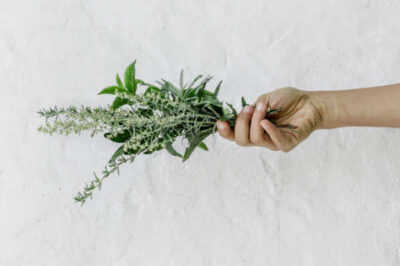The brutal cold of winter brings about thoughts of spring. Spring is a great time for planting herbs. Yes, herbs! Herbs have been around for centuries and are great way to make your meals tastier.
Some people grow their herbs from seed. If that is more than you want to do, you can kick-start your spring by buying herbs at a local nursery that has already grown the herbs from seed to young plant. Planting herbs in a small pot for growing in your home during cold early spring days is easy and fun. And they are a great source of deliciousness.
Basil, chives, parsley, sage and thyme are five simple herbs you can start early in the growing season in a decorative pot in your home. You’ll find your herbs will get an early jump on the growing season and fill your home with amazing aroma. Once the last frost has passed, you’ll be ready to transplant them outdoors. By that time, more varieties will be available at the nursery, and you can expand your collection of herbs based upon what your taste buds enjoy.
“Better is a dinner of herbs where love is than a fatted calf with hatred” (Prov. 15:17).
The Bible talks about the importance of being compassionate and caring with others as compared to being in a bad mood. Eating isn’t just something we have to do to sustain our physical body; it is an activity we can do daily to strengthen our relationships with others. Herbs accentuate both vegetables and meat. So, whether you plan to have a simple meal or a grand feast, you’ll find herbs add an incredible wow factor.
We reference herbs in several Faith & Fitness Magazine articles. Check them out and get cooking!
Take a closer look at basil, chives, parsley, sage and thyme. These are five herbs that to are easy to get started relatively early. The earlier you get started, the sooner you can make meals with a wow factor that is off the charts. This year, you can start a movement by growing your own herbs.
Basil / Ocimum basilicum
The history of basil goes back 4,000 years and was being used in Egypt. Basil was considered poisonous and as having transformative abilities. Today, because of its distinctive taste, it is used in salads, pizzas, sauces and other classic Italian dishes.
It is a bushy plant. Put it in a sunny area, and it is quite suitable for containers or garden beds. The leaves can be dried or frozen for up to two years.
Chives / Allium schoenoprasum
Chives were used in China nearly 5,000 years ago. They have been cultivated for centuries and was brought to America by the colonists. It was thought they had magical powers to keep disease and evil away. Chives are used as a garnish on salads, dips, soft cheeses and baked potatoes.
Chives are very easy to grow and flourish in containers. Chives have a milder flavor than either onions or garlic and are a good source of Vitamin C. Use them either fresh or dried.
Parsley / Petroselinum
Parsley is native to the Mediterranean shores of nearly 2,000 years ago, and records from the 15th century show its use in different varieties. In fact, it has the largest number of varieties among garden herbs. It is used as a garnish in soups or mixed into ground meat.
Parsley can be found almost anywhere. It is very easy to grow and is perfect for a home garden. Fresh is the best way to use it because of its texture, color and burst of fresh flavor.
Sage / Salvia officinalis
Sage was used for medicinal purposes and food preservation. Not until the 17th century was it used for flavoring food. It is best used at the beginning of cooking due to its strong flavor. Sage is added to stuffing and as a meat rub before grilling.
A hardy perennial, it can withstand tough conditions. The plant should have full sun and be replaced every three or four years. Sage can be used from a garden year-round and can be stored fresh in a zip-seal bag for up to two weeks in a refrigerator.
Thyme / Thymus
Thyme is native to the Mediterranean. The name originates from the Greek word thyro, to sacrifice, because of its use as an incense in temples. It is used to flavor many dishes, such as roasted vegetables, soups, sausages, stews, gravies and sauces.
The seeds are very tiny and are best planted in the early spring in nursery beds. It can be used either fresh or dried; generally, sprigs of thyme are used in cooking.
“Then God said, ‘See, I have given you every plant yielding seed which is on the face of all the earth and every tree which has fruit yielding seed. It shall be food for you'” (Gen. 1:29).
Growing herbs is both fun and simple. Try growing other herbs such as stevia, dill and cilantro. The possibilities are endless. You get a chance to see the marvels of God’s creation early in the season in your kitchen and then throughout the summer and autumn in your yard or on your patio.
Getting your family involved can instill a new level of interaction between each other. Don’t just stop there; involve a friend and incorporate herbs into a church fellowship dinner. Herbs can be an easy first step for you and other members of your church to make gardening a fresh expression of church.
You can trade herbs at a farmer’s markets, get involved with local organic farmers, and as you grow your garden, you may even be able to supply local restaurants with the herbs you grow. Use your imagination and get planting!
“Jesus said to them, ‘I am the bread of life. Whoever comes to Me shall never hunger, and whoever believes in Me shall never thirst'” (John 6:35). {eoa}
Adapted from Easy Herbs Make Your Meal Wow. Reprinted from Faith & Fitness Magazine. Used by permission.






Leave a Comment
You must be logged in to post a comment.